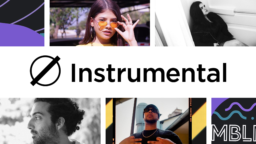The idea of Artificial Intelligence-supported A&R has become big news in the music business lately, with UK-based scouting tool Instrumental raising $4m for aggressive growth, and Warner Music Group acquiring Sodatone for an undisclosed fee. Here, Instrumental Founder & CEO (and ex-President of Warner Music Entertainment), Conrad Withey (pictured), argues that machine learning isn’t hurting the tradition of signing and developing artists – it’s improving it…
There has been a lot of noise in the music media recently predicting that bots will gradually take the place of experienced A&R teams, by making calls on what tracks or which artists are going to be hits.
People claim that this tech can accurately predict the likelihood of artist success in the future, and subsequently question the need for old school ears.
I even heard a recent alarming question concerning Instrumental’s own AI-driven scouting platform: ‘It’s listening to 20,000 songs a day – so who needs A&Rs?’
“AI offers the most exciting development in the world of talent discovery since the birth of the modern music business.”
Most of the time this kind of stuff is pure speculation, based on misunderstanding, or peddled by data scientists trying to make a name in an industry they don’t understand.
(Or it’s just a good punchline: a recent meeting at Instrumental HQ in London triggered this very article. MBW publisher Tim Ingham joked that – with both AI-supported A&R and AI-generated music continuing to emerge – we might soon be witnessing “robots signing robots”!)
My serious view is that AI offers the most exciting development in the world of talent discovery since the birth of the modern music business.
This isn’t about a binary choice between ‘gut instinct’ and ‘data’ – it’s about technology which helps all of us get better at what we do.

To get to the truth, let’s take a step back and look at what AI actually means. It’s a hot topic in investment circles right now, but it’s bandied around a lot without an enormous consideration for what machine learning is really all about.
A quick look at Wikipedia tells us that artificial intelligence (AI) or machine learning is “the field of computer science that uses statistical techniques to give computer systems the ability to ‘learn’ (i.e. progressively improve performance on a specific task) with data, without being explicitly programmed”.
That’s a helpful summary because it gets us to the crux of the matter: why might it be useful to employ machine learning in the process of scouting in the music business?
The music industry is drowning in data. There’s never been so much of it.”
The simple answer is that we are now drowning in data. There’s never been so much of it – from Spotify to SoundCloud, Shazam to SongKick and Instagram to YouTube it just goes on and on. And it’s only getting worse (or better, depending on your disposition).
Spotify – currently the biggest audio streaming platform by a country mile – recently confirmed that it’s adding 20,000 new tracks to its service every day. That’s 7 million+ each year!
Granted, the vast majority of these tracks won’t be of interest to most labels or publishers (the democratisation of the business has done great things, but it also means there is a lot of poor quality music out there).
However, within that 20k-a-day stat, there are definitely future hits and emerging stars.
As we all know, in 2018’s music business, playlisting is an essential A&R tool in itself: Spotify’s curators and algorithms drive streams, and streams drive commercial value.
On Instrumental’s platform we can see that there are currently over 8,000 ‘influential’ playlists in existence on Spotify – by which we mean those with 10,000 followers or more.
Within these playlists, as we stand today, there are 400,000+ artists and 45% of them are not on major labels – ie. they are on indie labels or self-releasing artists.
So that’s 20,000 new tracks a day, many of which are being added to 8,000 ‘influential’ playlists, harnessing 400,000 artists, of which nearly half (circa 180,000) are independent.
And that’s just on Spotify!
“45% of artists on Spotify’s most ‘influential’ playlists are not on major labels.”
Stats like these help us see both the problem and the opportunity for AI.
Clearly, tracking all of this music the old way just isn’t going to work. An A&R boss can employ as many interns or scouts as they like – they’re never going to be able to sort through all of that manually.
Who’s hot, who’s climbing in popularity, whose music is worth taking the gamble and investing in; this is all information the music business needs, in real time, to effectively compete.
AI can do that sorting for you in a nano-second.
By applying preferences to the way the data is filtered, through machine learning, you can achieve results that have been hyper-qualified to your strategy and tastes.
At that point, when you have the results, the power of ‘old school’ A&R really comes into play.
That’s when you can start measuring things in terms of the hairs on the back of your neck.
Armand Ruiz, Lead Product Manager at IBM Watson, said recently: “[The] purpose of AI is to augment human intelligence.” He’s absolutely right.
This is not about replacing human intelligence. It’s about helping us do the intelligent things which we are paid to do… better.
So, A&Rs: apply AI to the scouting process and then apply your ears to the super-qualified results.
By doing so, you will undoubtedly improve at what you’re employed to do.
Here’s another point I think people get hung up on: letting a machine power your scouting isn’t some sort of cop-out.
It doesn’t make you a lesser music executive or label.
“letting a machine power your A&R scouting isn’t some sort of cop-out. It doesn’t make you a lesser music executive or label.”
Let’s face it – scouting isn’t the music business’s most highly-valued skillset anyway. If it was it wouldn’t have been left to the most junior member of the team for the last 50 years!
Scouting is the start of the A&R journey. It is the discovery bit.
It is the process that comes before the bit where you truly start applying the skills, experience and instincts that a bot cannot come close to replicating.
But scouting is also critical. Do it badly and your music business… isn’t in business.
So, ‘Data vs Gut’ in A&R really isn’t a binary choice. In the computerised world of 2018, the music industry truly does need both.
It’s time to welcome the machine into the creative process – not to replace your gut instinct, but, actually, to empower it.Music Business Worldwide



